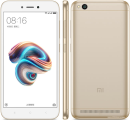Xiaomi Mi 5 Prices
Important Note.
- All prices are in Pakistani Rupee (PKR)
- Prices may vary at stores and our effort will be to provide you with the updated prices.
- Find out WhatMobile price has dropped in Pakistan by selecting Notify Price Drop button
- Find out WhatMobile has better specifications by clicking Add To Compare Button find out what Mobile has better reviews by visiting our reviews section
- Find out WhatMobile is cheaper on which retailer by clicking Compare prices from retailers button
Search Terms
- Xiaomi Mi 5
Specifications
| GENERAL | |
| 2G Network | GSM 850 / 900 / 1800 / 1900 - SIM 1 & SIM 2 |
|---|---|
| 3G Network | HSDPA 850 / 900 / 1900 / 2100 & TD-SCDMA CDMA2000 1xEV-DO - China |
| 4G Network | LTE band 1(2100), 3(1800), 5(850), 7(2600), 38(2600), 39(1900), 40(2300), 41(2500) - Global LTE band 1(2100), 3(1800), 7(2600), 38(2600), 39(1900), 40(2300), 41(2500) - China |
| Sim | Dual SIM (Nano-SIM, dual stand-by) |
| Announced | 07/02/2016 |
| Status | Available. Released 2016, April |
| BODY | |
| Dimensions | 144.6 x 69.2 x 7.3 mm (5.69 x 2.72 x 0.29 in) |
| Weight | 129 g / 139 g (Ceramic) (4.90 oz) |
| DISPLAY | |
| Display Size | 5.15 inches, 73.1 cm2 (~73.1% screen-to-body ratio) |
| Resolution | 1080 x 1920 pixels, 16:9 ratio (~428 ppi density) |
| MultiTouch | Yes |
| Protection | Corning Gorilla Glass 4 - MIUI 9.1 |
| SOUND | |
| AlertTypes | Vibration; MP3, WAV ringtones |
| LoudSpeaker | Yes |
| 3.5mm jack | Yes - Active noise cancellation with dedicated mic |
| MEMORY | |
| CardSlot | No |
| Internal | 32 GB, 3 GB RAM - other editions |
| DATA | |
| GPRS | Yes |
| EDGE | Yes |
| Speed | HSPA 42.2/5.76 Mbps, LTE-A (3CA) Cat12 600/150 Mbps |
| WLAN | Wi-Fi 802.11 a/b/g/n/ac, dual-band, Wi-Fi Direct, DLNA, hotspot |
| Blue Tooth | 4.2, A2DP, LE |
| InfraredPort | Yes |
| NFC | Yes |
| USB | Type-C 1.0 reversible connector |
| CAMERA | |
| Camera Primary | 16 MP (f/2.0, 1/2.8", 1.12 µm), phase detection autofocus, 4-axis OIS, dual-LED dual-tone flash, check quality |
| Camera Features | Geo-tagging, touch focus, face/smile detection, panorama, HDR |
| CameraVideo | 2160p@30fps, 1080p@30fps, 720p@120fps, check quality |
| CameraSecondary | 4 MP (f/2.0, 1/3", 2 µm), 1080p@30fps |
| FEATURES | |
| Processor Cores | Octa-Core |
| OS | Android 6.0 (Marshmallow), upgradable to 7.0 (Nougat) |
| CPU | Quad-core (2x1.8 GHz Kryo & 2x1.36 GHz Kryo) - Standard edition Quad-core (2x2.15 GHz Kryo & 2x1.6 GHz Kryo) - Prime & Pro edition |
| Sensors | Fingerprint (front-mounted), accelerometer, gyro, proximity, compass, barometer |
| Messaging | SMS(threaded view), MMS, Email, Push Mail, IM |
| Browser | HTML5 |
| Radio | No |
| GPS | Yes, with A-GPS, GLONASS, Yes, with A-GPS, GLONASS, BDS |
| Colors | Black, White, Gold, Ceramic |
| Others | - Fast battery charging (Quick Charge 3.0) - MP4/DivX/XviD/WMV/H.265 player - MP3/WAV/eAAC+/FLAC player - Photo/video editor - Document viewer |
| BATTERY | |
| Battery | Non-removable Li-Po 3000 mAh battery |
| MISC | |
| SARUS | 0.70 W/kg (head) 1.42 W/kg (body) |
Reviews

It’s been a long 18 months since Chinese smartphone powerhouse Xiaomi has released an update to its Mi 4 flagship, but that wait is finally over. At Mobile World Congress the week the company unveiled the Mi 5. While it doesn’t pack in some of the high-end features of other flagship smartphones unveiled this week, the Mi 5 is quite an update over the Mi 4—especially in the design department.
So how does Xiaomi make its phone so cheap? Surely if it was as easy as simply slapping a lower price tag on them at retail everybody, from Apple to Samsung, would be doing it. Much like OnePlus, Xiaomi is kind of a different beast compared to more traditional phone makers like Samsung, BlackBerry and Apple.
Essentially a start-up company, Xiaomi, like OnePlus before it, leveraged the internet, social networks and word of mouth to help raise the profile of its brand. This saves them HUGE sums of money. Case in point: Samsung once spent 12 billion on advertising in a single year -- more than Apple, McDonald's and pretty much any other business on the planet.
But OnePlus and Xiaomi’s success prove that their is another way to do it in the mobile space. And while Xiaomi is presently only really available inside China, the likelihood of the company expanding into the UK and US in the coming years is almost certain. Investors are always looking to make cash and brands like Xiaomi and OnePlus are exactly where it’s at with the stripped down, leaner approach to global domination.
The Mi 5 is Xiaomi's latest flagship. The device also comes in two versions: standard and the Pro. But how do those compare against the older Mi 4—just how much better are they? Let’s take a look!
Xiaomi Mi 5 vs Xiaomi Mi 4: RAM, CPU, and Storage
Here’s the specs for the Xiaomi Mi 4:
- Display: 5.0-inch display with 1920x1080 resolution at 441ppi
- Dimensions: 139.2mm x 68.5 mm x 8.9 mm
- Weight: 149 grams
- Storage: 16 or 64GB
- Memory: 2 or 3 GB RAM
- Processor: Qualcomm MSM8974AC Snapdragon 801
- Front camera: 8 MP
- Rear camera: 13 MP photos. ƒ/1.8 aperture
- Battery: 3080 mAh
- Colors: Black or White
And here’s the specs for the Xiaomi Mi 5:
- Display: 5.2-inch display with 1920x1080 resolution at 428 ppi
- Dimensions: 144.5mm x 62.9 mm x 7.2 mm
- Weight: 139 grams
- Storage: 32, 64, or 128 GB
- Memory: 3 or 4 GB RAM
- Processors: Qualcomm MSM8996 Snapdragon 820
- Front camera: 4 MP
- Rear camera: 16 MP, f/2.0 aperture
- Battery life: 3000 mAh
- Colors: Black, White, or Gold
The Mi 5 gets a not insignificant memory upgrade over the Mi 4. The older Mi 4 came with either 2GB or 3GB of RAM, depending on the model. The new Mi 5 ads an extra gigabyte to each: you’ll now get 3GB in the standard edition and 4GB in the Pro.
Storage has also gotten a boost. The Mi 4 came in 32GB and 64GB options. The Mi 5 still offers those, but if you buy the Pro edition you’ll be able to grab a 128GB size as well.
As for processors the Mi 4 features a relatively weak Snapdragon 801 chipset. The new Mi 5, however, packs in a top-end Snapdragon 820 CPU. The 820 leaves the 801 in the dust.
Xiaomi Mi 5 vs Xiaomi Mi 4: Design & Build
As for the material of the main body the standard edition Mi 5 features a glass back panel while the Pro edition has a ceramic body.
Despite the new materials, the Mi 5 actually comes in 10 grams lighter than the Mi 4. The Mi 5 is also significantly thinner than the Mi 4 at 7.2mm versus the Mi 4’s 8.9mm thickness. Both phones come in black or white, but the Mi 5 also has a gold option.
Xiaomi Mi 5 vs Xiaomi Mi 4: Display and Battery
As for displays, the Mi 5 gets a slightly larger display at 5.2-inches. That compares to the Mi 4’s 5.0-inch display. The disappointing thing is the Mi 5 is still stuck at the same 1920x1080 resolution that the Mi 4’s display has. Because of that, and because the screen is a bit larger, it means the Mi 5 display actually has a lower ppi at 428 versus the Mi 4’s 441 ppi.
The Mi 5 also has a smaller battery pack inside. It features a 3000mAh battery versus the Mi 4’s 3080 mAh battery. However, the difference isn’t that big and chances are the Mi 5’s battery will last just as long or longer than the Mi 4 due to more energy efficient components.
Xiaomi Mi 5 vs Xiaomi Mi 4: Cameras
What’s interesting is the Mi 4 has a much better front camera than the Mi 5: 8MP versus the Mi 5’s 4MP. We’re a little confused as to why the downgrade too. However, the four megapixels the Mi 5 lost in front gets added to its rear camera, now coming in at 16MP virus the Mi 4’s 12MP rear sensor. Both shoot video up to 2160p at 30fps.
Xiaomi Mi 5 vs Xiaomi Mi 4: Verdict
Despite the front camera downgrade and the slightly smaller battery, the Mi 5 is the clear winner over the Mi 4. It’s got a much faster processor, more RAM, and has a higher top-level storage option. It’s body and design have also received a much welcome—and sexier—glass or ceramic upgrade over the old plastic Mi 4. There’s no question about it, between these two models the Mi 5 is the one to get.
Write Your Own Review
My Recent Reviews
- Be first to post review for this product.
comments powered by Disqus











.jpg)



















